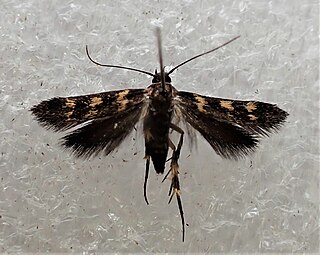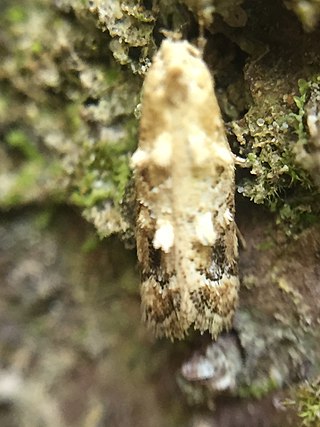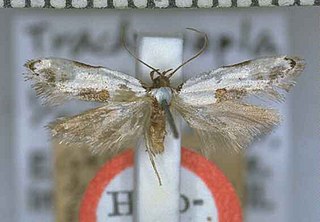
Zealandopterix zonodoxa is a moth of the family Micropterigidae. It is endemic to New Zealand and is located from Hawkes Bay north as well as on Poor Knights, Little Barrier and the Great Barrier Islands. It is the smallest micropterigid in New Zealand and the shiny white markings on the forewing of this species display variation. It is a moth that is active during the day, but has been collected using UV light. Adults are on the wing from September to March and the species has been witnessed visiting the flowers of Nīkau and Cordyline pumilio in large numbers. It inhabits a wide variety of moist indigenous forest but is associated with forests in which podocarps are common. Larvae have been sieved from rotten wood on the floor of a mixed podocarp/broadleaf forest or extracted from moss or from bryophytes.

Izatha prasophyta is a moth of the family Oecophoridae. It is endemic to New Zealand, where it is known from the North Island, except Hawkes Bay or the Wairarapa. Larvae likely feed on rotting wood although larvae of this species have been reared on the fruiting body of the bracket fungus Bjerkandera adusta. Adults are on the wing from November to February.

Izatha rigescens is a species of moth in the family Oecophoridae. It is endemic to New Zealand. This species is classified as having the conservation status of "Data Deficient" by the Department of Conservation. It is only known from the Wellington coast. This species has not been seen since 1929.

Phycomorpha metachrysa, the milktree fruit moth, is a species of moth in the Copromorphidae family. It is endemic to New Zealand and has been found in the North and South Islands. The larvae feed on the fruit of species in the genus Streblus including Streblus heterophyllus. This adults of this species is on the wing from October to April.

Amblyptilia epotis is a moth of the family Pterophoridae. It is endemic to New Zealand and is found in the South and Stewart Islands. It inhabits mountainous terrain covered in alpine vegetation or alternatively alpine wetland habitat. The adults of this species are on the wing from February to March. In appearance the adults of this species are variable in colour however this species can be distinguished from similar species by the oblique apical streak on its forewings as well as the patch of white on the costa cilia towards the apex of the forewing.

Chersadaula ochrogastra is a species of moth in the family Oecophoridae. This species is endemic to New Zealand. It is classified as "Data Deficient" by the Department of Conservation.

Schiffermuelleria orthophanes is a moth of the family Oecophoridae. It is endemic to New Zealand. It is classified as critically endangered by the Department of Conservation.

Stathmopoda campylocha is a species of moth in the family Stathmopodidae. It is endemic to New Zealand. It is classified as critically endangered by the Department of Conservation.

Pyrgotis eudorana is a species of moth of the family Tortricidae. It is endemic in New Zealand and has been observed in both the North and South Islands. However it is regarded as a rare insect. This species inhabits native forest. Larvae exclusively feed on Muehlenbeckia australis and adults are on the wing from November to April. Adults are attracted to light.

Pyrausta comastis is a moth in the family Crambidae. This species is endemic to New Zealand. It has been classified as "nationally vulnerable" by the Department of Conservation.

Athrips zophochalca is a moth of the family Gelechiidae. It was described by Edward Meyrick in 1918 and is endemic to New Zealand. A. zophochalca has been observed in both the North and South Islands as well as at the Poor Knights. The species inhabits scrubby native forest, saline wetlands and braided river habitat. Larvae bore into the terminal shoots of Carmichaelia species. Adults are on the wing from November until March and are sexually dimorphic with the male lacking the white band on the forewings.

Erechthias chasmatias is a species of moth in the family Tineidae. It was first described by Edward Meyrick in 1880. This species is endemic to New Zealand and is found in the North Island. This species inhabits native bush. Adults are on the wing from October to April and have been collected by beating small trees and foliage.

Sagephora felix is a species of moth in the family Tineidae. It was described by Edward Meyrick in 1914. This species is endemic to New Zealand and can be found in the north half of the North Island. It inhabits native forest and adults of the species are on the wing from December to May, in July and November.

Hierodoris stella is a species of moth in the family Oecophoridae. This species is endemic to New Zealand and occurs in Auckland, Taranaki, Hawkes Bay, Bay of Plenty and Wellington. As at 2005 the larvae of this species is unknown as is its host plant. The adult moth frequents forest and are on the wing in January and February. It is classified as "At Risk, Relict'" by the Department of Conservation.

Austrocidaria lithurga is a species of moth in the family Geometridae. It is endemic to New Zealand. This moth is classified as at risk, naturally uncommon by the Department of Conservation.

Cateristis eustyla is a species of moth in the family Tineidae. This species is found in New Zealand and Tasmania. It is classified as "Data Deficient" by the Department of Conservation.

Lathicrossa prophetica is a species of moth of the family Oecophoridae. It is endemic to New Zealand and has been found in both the North and South Islands. This species inhabits sub-alpine native forest and adults are on the wing in January. It is classified as "Data Deficient" by the Department of Conservation.

Tingena chrysogramma is a species of moth in the family Oecophoridae. It is endemic to New Zealand and is found in the North and South Islands. The adults of this species inhabits open scrubland and are on the wing in January and February. It has been collected via light traps and beating shrubs. During sunny days this species has been observed resting on leaves and rarely flies. It is regarded as a rare species and has a possible association with Prumnopitys ferruginea.

Trachypepla aspidephora is a species of moth in the family Oecophoridae. It is endemic to New Zealand and has been observed in the North and South Islands. Adults are on the wing from November to March and are attracted to light. The moths can be found resting on tree trunks where their colouration imitates lichens.

Trachypepla hieropis is a moth of the family Oecophoridae first described by Edward Meyrick in 1892. It is endemic to New Zealand and has been collected in both the North and South Islands. This species inhabits native forest and the larvae feed on leaf litter. Adults are on the wing in December and are attracted to light.






















